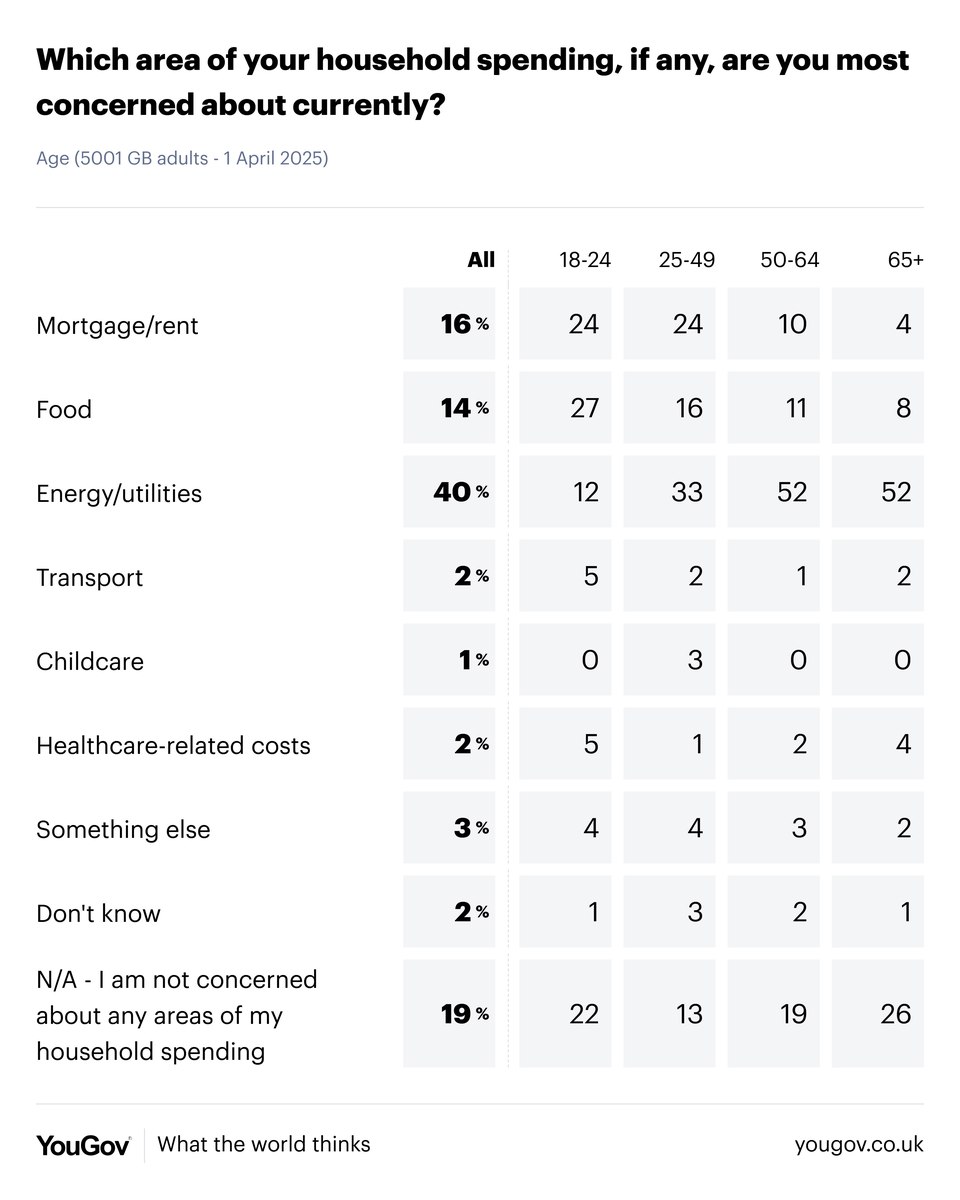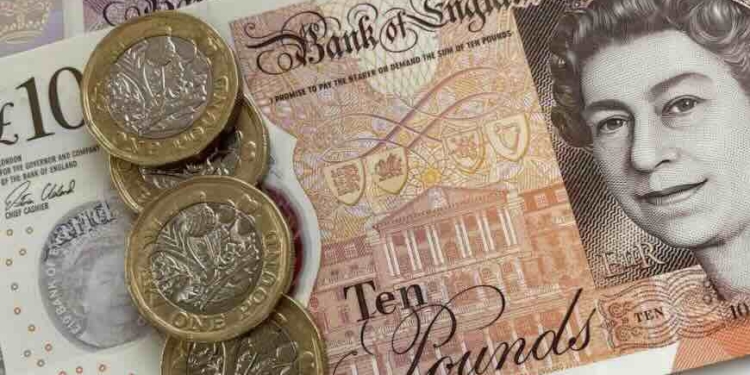Cost of Living: This month, most households will be hit by a range of tax and bill increases, with everything from council tax to television licences on the up, alongside the raising of the energy price cap
Energy bills are the area of spending Britons are most likely to be concerned about, with 40% saying it is their top concern, relative to 16% saying so of housing costs and 14% of food. One in five Britons (19%), however, say there are no areas of household spending they are concerned about.
Not all parts of the public share the same problems. While 52% of over 50s say energy costs are their biggest concern, this is true of 33% of 25-49 year olds and just 12% of 18-24 year olds. By contrast, a quarter of under 50s (24%) say housing costs are their biggest worry, relative to 4% of over 65s, while 27% of 18-24 year olds see the cost of food as their top concern, compared to 8% of those aged 65 and over.

Cost of Living Dynamics in the UK (2015–2025)
Factors Impacting Changes Over the Decade
-
Brexit (2016–2021)
The 2016 referendum and subsequent exit from the EU in 2020 increased import costs, notably for food (50% of UK supply is imported). The London School of Economics found Brexit raised food prices by 6% due to trade barriers, disproportionately hitting poorer households. -
COVID-19 Pandemic (2020–2022)
Global supply chain disruptions and pent-up demand post-lockdowns drove inflation. Energy prices doubled as markets reopened, with the average gas bill rising from £600 in 2021 to £1,100 in 2022, per the House of Commons Library. -
Russia-Ukraine War (2022–Ongoing)
The 2022 invasion spiked energy and food costs. The UK, reliant on gas for 40% of electricity and 85% of home heating, saw energy bills remain 40% above pre-crisis levels into 2025, per The Guardian. Food inflation hit 19.1% in March 2023, the highest since 1977. -
Housing Market Pressures
A chronic shortage of affordable housing—1.1 million units lost since 1996—pushed rents and property prices up. London’s average home price reached £706,159 in 2024, per Expatica, far outstripping wage growth (33% from 1970–2007, flat since). -
Policy and Privatization
Privatized energy and rail sectors have kept costs high. Ofgem’s 54% energy price cap hike in April 2022 and rail fares 23% above 1995 levels (Corporate Watch) reflect profit-driven pricing. Tax rises, projected to hit 37% of GDP by 2027/28, add £4,200 per household, per the Resolution Foundation.
Comparison with European Countries
-
Housing: UK housing costs are 44% higher than the OECD average, per posts on X. In contrast, Denmark capped rent increases at 4% for two years in 2022, France at 3.5%, and Spain at 2%, while UK rents rose 9.1% in 2024. Germany’s tighter rent controls keep costs lower, with Berlin’s average rent at €1,200 versus London’s £1,480 monthly.
-
Energy: UK utility bills (£671 for electricity, £729 for gas annually in 2025) exceed much of Europe due to gas reliance and privatization. Ireland’s €200 energy credits and Spain’s VAT cuts to 5% on electricity softened the blow, unlike the UK’s £400 universal discount, which ended in 2023.
-
Food: UK food prices rose 20.8% from 2021–2024, higher than Germany (20.9%), the US (18.8%), and France (16.6%), per the House of Commons Library, reflecting Brexit-related import costs absent in EU nations.
-
Income and Purchasing Power: UK real wages have stagnated since 2007, costing workers £10,700 annually in lost growth, per the Resolution Foundation. German low-income families are 21% (£2,300) better off yearly, and Dutch families 39%, per X posts, due to stronger social safety nets and wage growth.
-
Inflation Trends: The UK’s peak inflation (11.1%) exceeded G7 peers like Germany (8.8%) and France (7.3%). While it fell to 2% by May 2024, matching France and the US, the cumulative price rise since 2021 (22.8%) outpaces them, per the House of Commons Library.
Pricelist of Most Used Grocery Items and Utility Services (April 2025)
Based on ONS, Which?, and Ofgem data, adjusted for recent trends:-
Groceries (Average prices from Tesco, reflecting a typical basket):
-
White Bread (800g): £1.10
-
Milk (2L): £1.50
-
Eggs (6 large): £2.00
-
Chicken Breast (1kg): £7.50
-
Pasta (500g): £0.90
-
Potatoes (2.5kg): £2.20
-
Tomatoes (1kg): £2.80
-
Vegetable Oil (1L): £2.60
-
Sugar (1kg): £1.20
-
Tea Bags (80): £2.50
-
-
Utilities (Annual averages for a typical household, per Ofgem and House of Commons Library):
-
Electricity: £671 (27.03p/kWh, 53.80p/day standing charge, up 6% from Q1 2025)
-
Gas: £729 (6.99p/kWh, 32.67p/day standing charge, up 6%)
-
Water: £603 (up 26% from £480 in 2024, per X posts and industry estimates)
-
Broadband (Sky): £360 (up 6.2%, £30/month)
-
-
Cost of Living: This month, most households will be hit by a range of tax and bill increases, with everything from council tax to television licences on the up, alongside the raising of the energy price cap
Energy bills are the area of spending Britons are most likely to be concerned about, with 40% saying it is their top concern, relative to 16% saying so of housing costs and 14% of food. One in five Britons (19%), however, say there are no areas of household spending they are concerned about.
Not all parts of the public share the same problems. While 52% of over 50s say energy costs are their biggest concern, this is true of 33% of 25-49 year olds and just 12% of 18-24 year olds. By contrast, a quarter of under 50s (24%) say housing costs are their biggest worry, relative to 4% of over 65s, while 27% of 18-24 year olds see the cost of food as their top concern, compared to 8% of those aged 65 and over.

Cost of Living Dynamics in the UK (2015–2025)
Factors Impacting Changes Over the Decade
-
Brexit (2016–2021)
The 2016 referendum and subsequent exit from the EU in 2020 increased import costs, notably for food (50% of UK supply is imported). The London School of Economics found Brexit raised food prices by 6% due to trade barriers, disproportionately hitting poorer households. -
COVID-19 Pandemic (2020–2022)
Global supply chain disruptions and pent-up demand post-lockdowns drove inflation. Energy prices doubled as markets reopened, with the average gas bill rising from £600 in 2021 to £1,100 in 2022, per the House of Commons Library. -
Russia-Ukraine War (2022–Ongoing)
The 2022 invasion spiked energy and food costs. The UK, reliant on gas for 40% of electricity and 85% of home heating, saw energy bills remain 40% above pre-crisis levels into 2025, per The Guardian. Food inflation hit 19.1% in March 2023, the highest since 1977. -
Housing Market Pressures
A chronic shortage of affordable housing—1.1 million units lost since 1996—pushed rents and property prices up. London’s average home price reached £706,159 in 2024, per Expatica, far outstripping wage growth (33% from 1970–2007, flat since). -
Policy and Privatization
Privatized energy and rail sectors have kept costs high. Ofgem’s 54% energy price cap hike in April 2022 and rail fares 23% above 1995 levels (Corporate Watch) reflect profit-driven pricing. Tax rises, projected to hit 37% of GDP by 2027/28, add £4,200 per household, per the Resolution Foundation.
Comparison with European Countries
-
Housing: UK housing costs are 44% higher than the OECD average, per posts on X. In contrast, Denmark capped rent increases at 4% for two years in 2022, France at 3.5%, and Spain at 2%, while UK rents rose 9.1% in 2024. Germany’s tighter rent controls keep costs lower, with Berlin’s average rent at €1,200 versus London’s £1,480 monthly.
-
Energy: UK utility bills (£671 for electricity, £729 for gas annually in 2025) exceed much of Europe due to gas reliance and privatization. Ireland’s €200 energy credits and Spain’s VAT cuts to 5% on electricity softened the blow, unlike the UK’s £400 universal discount, which ended in 2023.
-
Food: UK food prices rose 20.8% from 2021–2024, higher than Germany (20.9%), the US (18.8%), and France (16.6%), per the House of Commons Library, reflecting Brexit-related import costs absent in EU nations.
-
Income and Purchasing Power: UK real wages have stagnated since 2007, costing workers £10,700 annually in lost growth, per the Resolution Foundation. German low-income families are 21% (£2,300) better off yearly, and Dutch families 39%, per X posts, due to stronger social safety nets and wage growth.
-
Inflation Trends: The UK’s peak inflation (11.1%) exceeded G7 peers like Germany (8.8%) and France (7.3%). While it fell to 2% by May 2024, matching France and the US, the cumulative price rise since 2021 (22.8%) outpaces them, per the House of Commons Library.
Pricelist of Most Used Grocery Items and Utility Services (April 2025)
Based on ONS, Which?, and Ofgem data, adjusted for recent trends:-
Groceries (Average prices from Tesco, reflecting a typical basket):
-
White Bread (800g): £1.10
-
Milk (2L): £1.50
-
Eggs (6 large): £2.00
-
Chicken Breast (1kg): £7.50
-
Pasta (500g): £0.90
-
Potatoes (2.5kg): £2.20
-
Tomatoes (1kg): £2.80
-
Vegetable Oil (1L): £2.60
-
Sugar (1kg): £1.20
-
Tea Bags (80): £2.50
-
-
Utilities (Annual averages for a typical household, per Ofgem and House of Commons Library):
-
Electricity: £671 (27.03p/kWh, 53.80p/day standing charge, up 6% from Q1 2025)
-
Gas: £729 (6.99p/kWh, 32.67p/day standing charge, up 6%)
-
Water: £603 (up 26% from £480 in 2024, per X posts and industry estimates)
-
Broadband (Sky): £360 (up 6.2%, £30/month)
-
-































Discussion about this post